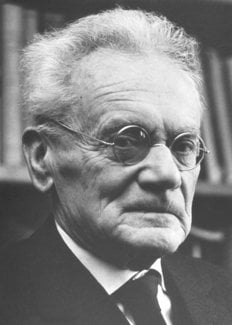Karl von Frisch
Biographical

I was born on 20 November 1886 in Vienna, the son of university professor Anton Ritter von Frisch and his wife Marie, née Exner. I studied at a grammar school and later at the University of Vienna in the Faculty of Medicine. After the first exams, I switched to the Faculty of Philosophy and studied Zoology in Munich and Vienna. I received my doctorate from the University of Vienna in 1910. In the same year I became assistant to Richard Hertwig at the Zoological Institute at the University of Munich. There I gained my University Teaching Certificate in Zoology and Comparative Anatomy.
In 1921 I went to the University of Rostock as Professor and Director at the Zoology Faculty; in 1923 I moved to Breslau and in 1925 I succeeded my former teacher Richard Hertwig in Munich. With support from the Rockefeller Foundation I oversaw the building of a new Zoological Institute with the best facilities available. After the destruction of the latter during the Second World War, I went to Graz in 1946, but returned to Munich in 1950 after the Institute had been reopened. I have been a Professor Emeritus since 1958, and have continued my scientific studies. Of my published papers the following are the most important:
Der Farben und Formensinn der Bienen: Zoologische Jarbücher (Physiologie) 35, 1-188, (1914-15). (The bee’s sense of colour and shape.)
Über den Geruchssinn der Bienen und seine blütenbiologische Bedeutung: Zoologische Jahrbücher (Physiologie) 37, 1-238 (1919). (The bee’s sense of smell and its significance during blooming.)
Über die “Sprache” der Bienen. Eine tierpsychologische Untersuchung: Zoologischer Jahrbücher (Physiologie) 40, 1-186 (1923). (Bee’s ‘language’- an examination of animal psychology.)
Untersuchung über den Sitz des Gehörsinnes bei der Elritze: Zeitschrift für vergleichende Physiologie 17, 686-801 (1932), with R. Stetter. (Examination into the position of the sense of hearing in the minnow.)
Über den Geschmachsinn der Bienen: Zeitschrift für vergleichende Physiologie 21, 1-156 (1934). (The bee’s sense of taste.)
Über einen Schreckstoff der Fischhaut und seine biologische Bedeutung: Zeitschrift für vergleichende Physiologie 29, 46-145 (1941). (On the repellant substance on fish skin and its biological significance.)
Die Tänze der Bienen: Österreichische Zoologische Zeitschrift 1, 1-48 (1946). (The bee’s dances.)
Die Polarisation des Himmelslichtes als orientierender Faktor bei den Tänzen der Bienen: Experientia (Basel) 5, 142-148 (1949). (The polarisation of skylight as a means of orientation during the bee’s dances.)
Die Sonne als Kompaß im Leben der Bienen: Experientia (Basel) 6, 210-221 (1950). (The sun as compass in the life of bees.)
Tanzsprache und Orientierung der Bienen, Springer Verlag Berlin-Heidelberg-New York (1965). (The Dance Language and Orientation of Bees, Harvard University Press, 1967.)
This autobiography/biography was written at the time of the award and first published in the book series Les Prix Nobel. It was later edited and republished in Nobel Lectures. To cite this document, always state the source as shown above.
Karl von Frisch died on June 12, 1982.
Nobel Prizes and laureates
Six prizes were awarded for achievements that have conferred the greatest benefit to humankind. The 12 laureates' work and discoveries range from proteins' structures and machine learning to fighting for a world free of nuclear weapons.
See them all presented here.
